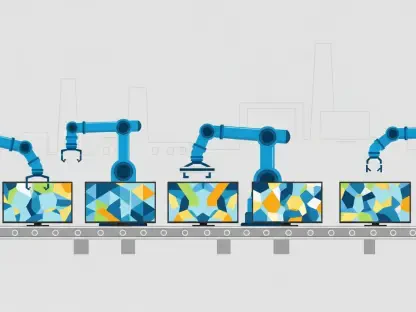In a world increasingly defined by connectivity, the Internet of Things (IoT) market stands at a pivotal moment of recovery, with billions of devices shaping industries from smart homes to industrial automation. Amid this dynamic landscape, Silicon Laboratories (SLAB) emerges as a significant contender, navigating a complex environment of robust demand and formidable challenges. With the IoT sector projected to expand to 18.8 billion connected devices at a growth rate of 13% this year, the stakes are high for companies like SLAB to capitalize on emerging opportunities. Despite macroeconomic pressures such as high interest rates and inflation curbing enterprise spending, SLAB has shown remarkable resilience with a 33% year-over-year revenue surge in the second quarter. This performance underscores a strategic positioning that could redefine its role in the industry. As geopolitical tensions and supply chain disruptions loom large, understanding SLAB’s approach offers critical insights into the broader recovery cycle and the potential for sustained growth in this vital sector.
Navigating the IoT Market Dynamics
Growth Trends and Segment Performance
The IoT market’s current trajectory reveals a blend of opportunity and caution, with growth slightly tempered compared to previous years but still significant at a projected 13% expansion. Silicon Laboratories has adeptly positioned itself within this evolving space, leveraging structural trends in both industrial and consumer applications to drive impressive financial results. The company’s Industrial & Commercial segment, generating $110 million in revenue, achieved a 25% year-over-year increase, fueled by design wins in industrial IoT and smart energy solutions. This success reflects a growing reliance on connected systems to optimize operations across various sectors. Meanwhile, the Home & Life segment outpaced expectations with a 45% revenue jump to $83 million, driven by rising demand for connected healthcare devices and smart home technologies. Such dual-segment strength highlights SLAB’s ability to cater to diverse needs, from mission-critical industrial systems to consumer-focused innovations, positioning it as a versatile player in a fragmented yet rapidly expanding market.
Beyond raw numbers, the strategic importance of these segments lies in their alignment with long-term industry shifts toward automation and connectivity. Industrial IoT applications are increasingly integral to enhancing efficiency in manufacturing and energy management, areas where SLAB’s expertise in secure, reliable solutions provides a competitive edge. On the consumer side, the surge in smart home adoption and health-focused devices taps into a cultural shift toward personalized technology, where user experience and integration are paramount. The company’s ability to balance these distinct yet interconnected markets demonstrates a nuanced understanding of IoT’s multifaceted growth drivers. While challenges like cautious enterprise spending due to economic headwinds persist, SLAB’s recent performance suggests a robust foundation for capitalizing on these trends. This adaptability not only strengthens its market presence but also sets a benchmark for how semiconductor firms can thrive amid fluctuating demand cycles and evolving customer priorities.
Macroeconomic and Geopolitical Challenges
Despite the promising growth in IoT adoption, Silicon Laboratories faces substantial hurdles shaped by broader economic and geopolitical forces. Persistent supply chain constraints continue to plague the semiconductor industry, with lead times still elevated compared to pre-pandemic levels, posing risks to timely delivery and scalability. These disruptions are compounded by inflationary pressures that squeeze margins and force tough decisions on pricing and cost management. For a company reliant on global manufacturing hubs, such operational challenges demand innovative strategies to maintain growth momentum. The uncertainty around supply availability not only affects production schedules but also impacts customer confidence, making it imperative for SLAB to explore alternative sourcing or nearshoring options to mitigate these risks and ensure continuity in a volatile market environment.
Adding to the complexity are geopolitical tensions that reshape the industry’s landscape, particularly in U.S.-China relations affecting semiconductor trade. A temporary tariff pause earlier this year provided some relief, but the imposition of a 100% tariff on certain foreign semiconductors by the current administration has altered cost structures significantly. For SLAB, this means navigating a fragmented trade environment where sourcing strategies must adapt to avoid margin erosion. The World Trade Organization’s projections of sectoral realignments further signal potential disruptions in cross-border design win cycles, challenging the company’s global operational model. These external pressures underscore the need for agility in strategic planning, as geopolitical shifts could influence long-term growth if not addressed through proactive measures like localized production or enhanced pricing power to offset rising costs.
Strategic Positioning and Future Outlook
Technological Innovation and Competitive Strengths
Silicon Laboratories stands out in the IoT arena through its commitment to technological innovation, a cornerstone of its competitive strategy. The adoption of the Series 2 platform and the anticipated launch of the SiXG302 device, tailored for energy-efficient applications, exemplify the company’s focus on meeting modern IoT demands. Additionally, the PSA Level 4 certification for the SiXG301 device enhances its credibility in security-sensitive sectors like industrial and healthcare IoT, where data protection is non-negotiable. This emphasis on cutting-edge solutions addresses critical enterprise concerns about vulnerabilities, positioning SLAB as a trusted partner in a market increasingly defined by the need for robust, secure connectivity. Such advancements not only differentiate the company from competitors but also align with the industry’s push toward sustainable and safe technology ecosystems.
However, maintaining this edge requires navigating competitive pricing pressures and declining gross margins in commoditized segments of the IoT market. While SLAB’s forward price-to-earnings ratio of 114.6 suggests optimism about future growth, it also reflects vulnerability to macroeconomic volatility that could temper investor confidence. The company’s ability to sustain profitability hinges on balancing innovation with operational efficiency, ensuring that R&D investments yield high-margin outcomes. Strategic design wins in high-growth areas like industrial automation further bolster its market stance, but the challenge lies in scaling these successes amidst intensifying competition. By prioritizing energy efficiency and security in its product roadmap, SLAB can continue to carve out a niche, provided it adapts swiftly to pricing dynamics and customer expectations in an ever-shifting technological landscape.
Financial Resilience and Investment Considerations
Financially, Silicon Laboratories demonstrates commendable discipline, with non-GAAP gross margins steady at 56.3%, a figure that outperforms many peers grappling with inflationary costs. Despite a GAAP operating loss of $23 million in the second quarter, the non-GAAP operating income of $1 million signals a trajectory toward profitability as operational scale improves. Management’s projection for third-quarter revenue between $200 and $210 million, coupled with an expected non-GAAP gross margin increase to 57–58%, reflects confidence in leveraging volume growth to counter cost pressures. This financial stability, rooted in strategic cost management and revenue diversification, positions SLAB to weather economic uncertainties while investing in future-focused technologies that drive long-term value in the IoT sector.
From an investment perspective, the outlook for SLAB presents a nuanced balance of opportunity and caution. Strong growth metrics and technological leadership make it an appealing choice for those willing to embrace risk, particularly in a recovering IoT market. However, the high forward P/E ratio and external challenges like supply chain disruptions and geopolitical uncertainties suggest potential volatility that could impact returns. Investors must carefully assess the company’s proven momentum against these broader risks, considering how macroeconomic factors might influence sustained growth. The path to enduring success for SLAB will depend on its agility in navigating global challenges while capitalizing on design wins and operational efficiencies, offering a compelling yet complex case for investment in the evolving connectivity landscape.
Reflecting on Market Navigation
Looking back, Silicon Laboratories carved a notable path through the IoT recovery cycle, balancing impressive revenue growth with the weight of macroeconomic and geopolitical challenges. The company’s dual-segment achievements in industrial and consumer markets, alongside a steadfast commitment to innovation, underscored its resilience in a turbulent environment. Financial discipline and strategic product advancements further cemented its standing, even as supply chain issues and trade tensions tested operational limits. For stakeholders, the journey revealed a blend of promise and prudence, where SLAB’s adaptability stood out. Moving forward, the focus should shift to actionable strategies—enhancing localized production to mitigate tariff impacts, prioritizing high-margin sectors, and accelerating security-focused innovations. These steps could fortify SLAB’s position, ensuring it not only weathered past storms but also built a stronger foundation for future growth in the ever-connected world of IoT.









